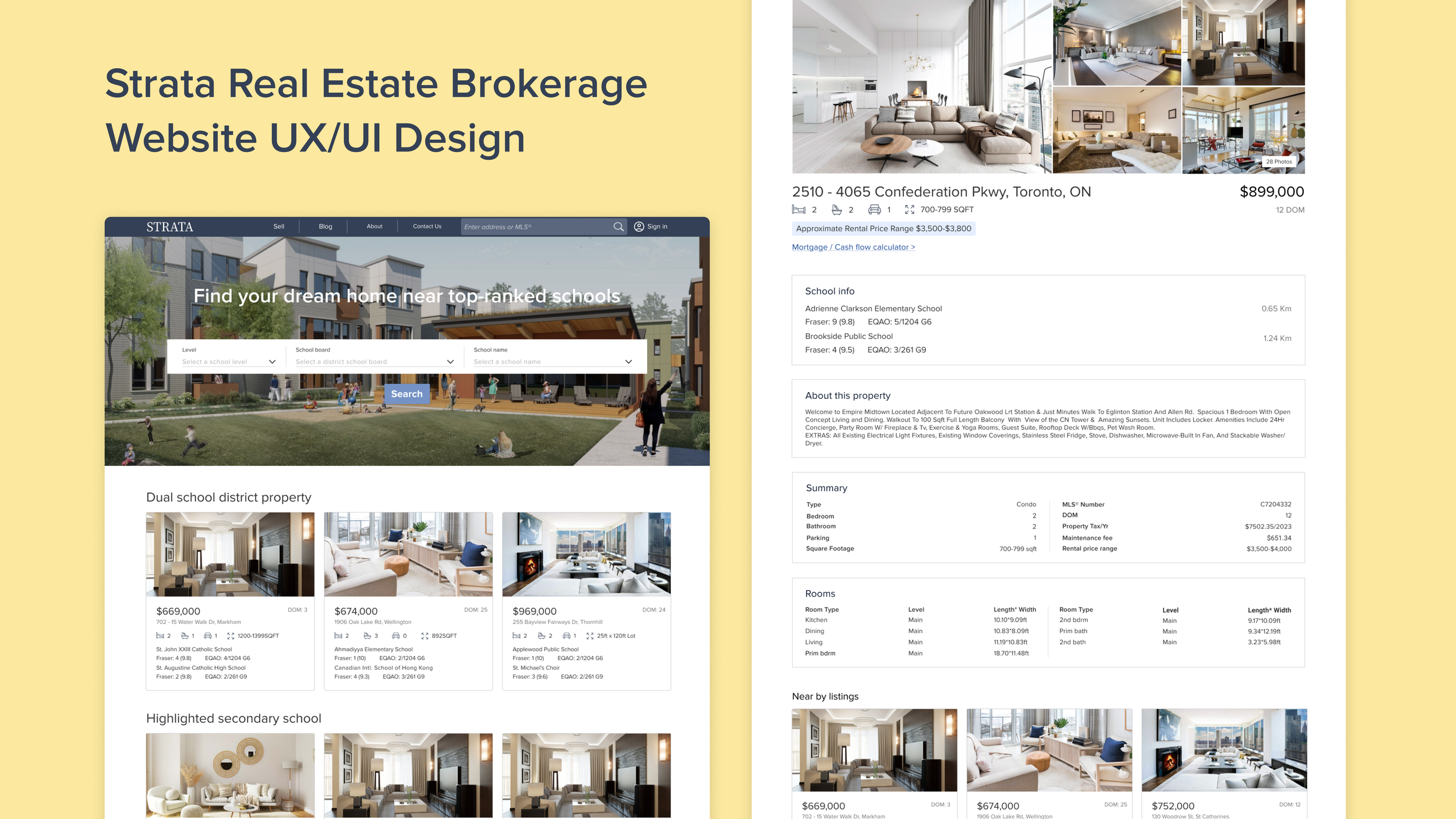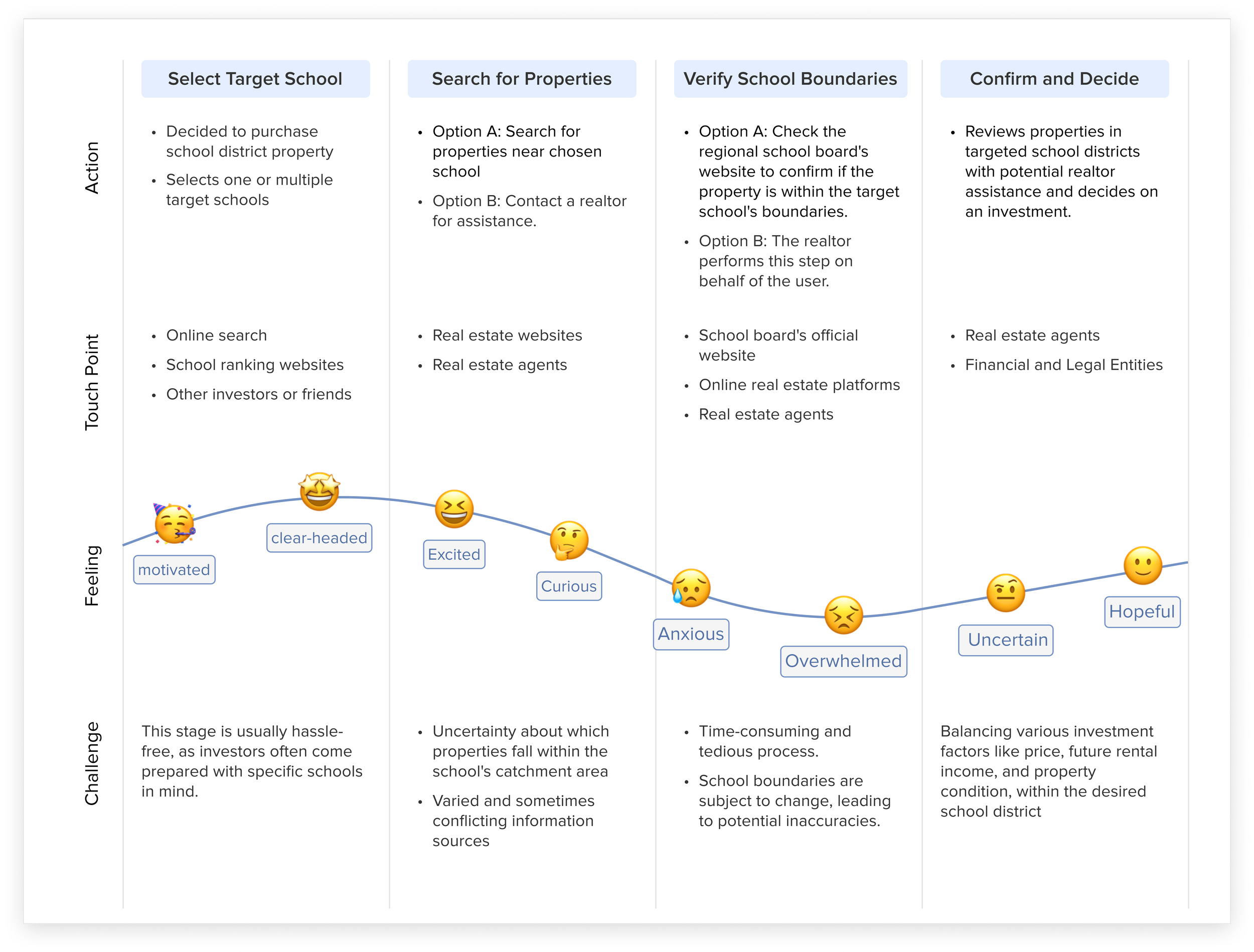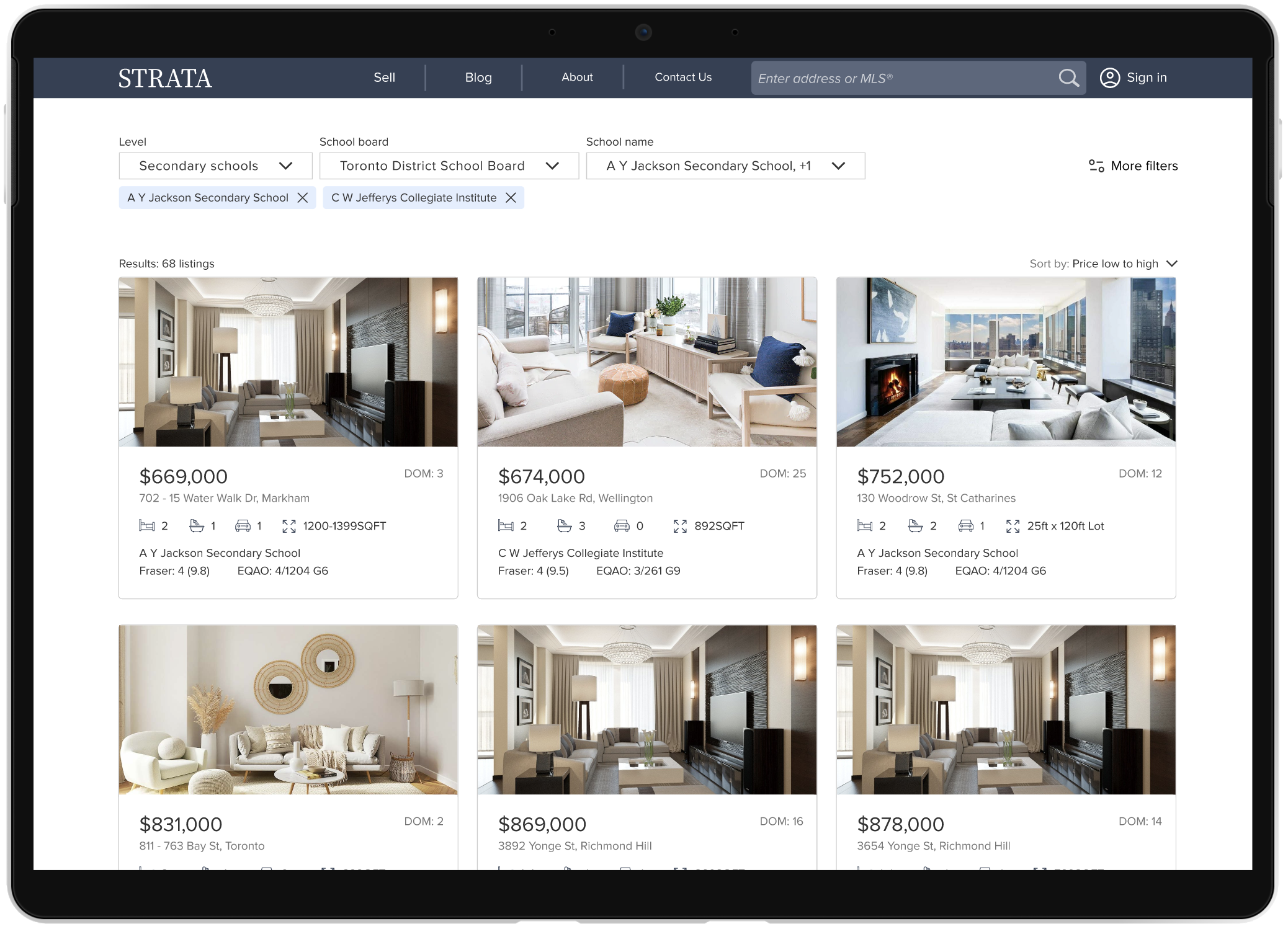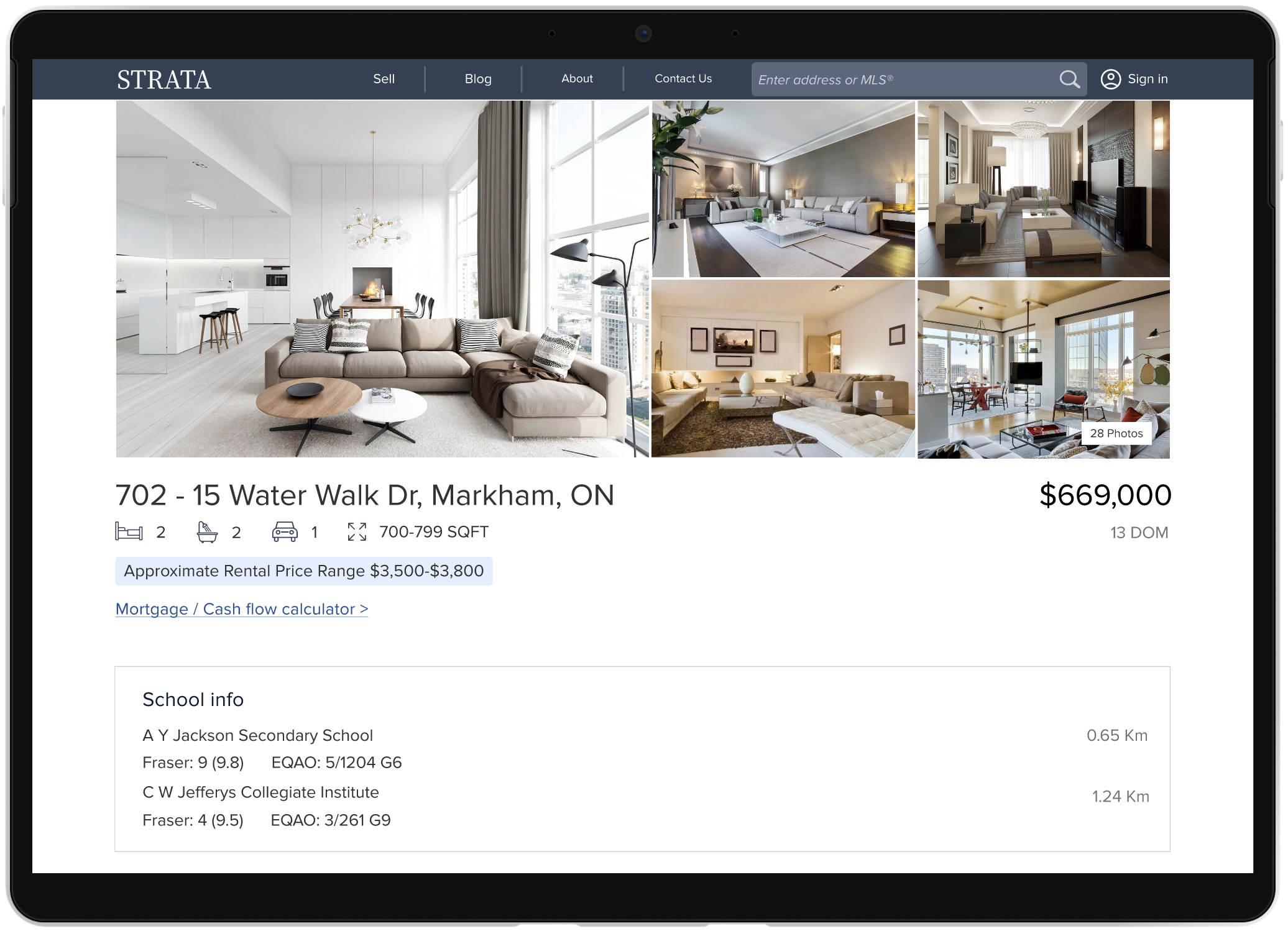Strata Web UX/UI Design
THE CHALLENGE
Standing out in the GTA real estate market by targeting school district investors.
In the competitive Greater Toronto Area (GTA) real estate market, Strata Realty must differentiate itself to gain an edge. A key demographic, investors seeking homes in top school districts, represents a significant opportunity. These investors, motivated by the prospect of providing a superior educational environment for their children, consider not just the property but the educational future it secures. Strata Realty's challenge is to stand out in a saturated market by catering to the unique demands of these education-oriented investors.
My role
I created the design of the property search experience tailored for school district home buyers between October 2022 and March 2023.
I conducted the user research, competitive analysis, and design aspects, working closely with the product manager to determine the project's scope and profitability.
Additionally, I collaborated with developers to assess the technical feasibility of the project.
Solution Highlight
Understand the users
To understand the demand of our targeted users, I conducted interviews with 10 sales representatives within our team that gave me relatively accurate results, especially given their direct interaction with clients.
Motivation
Secure good education opportunity
Parents aim to secure properties that ensure access to quality education for their children.
Long-term value appreciation
Good schools often indicate stable or improving neighborhoods, which in the long-term will generate higher returns.
Recession-proof
They believe properties in good school districts are recession-proof investments.
User Needs
Proximity to top-rated schools
Prioritize properties near top-rated schools to enhance educational opportunities for their children and to improve investment potential.
Income cover expenditure
Seek properties where the rental income is sufficient to cover mortgage payments and maintenance costs.
Current Process
“Some of them contact us directly for insights and often have specific schools or areas in mind.”
“Others have done preliminary research of the properties online using real estate websites or apps before approaching us for specific listings.”
Challenge
Identify school boundaries
Users find it difficult to determine which properties are located within the boundaries of their desired schools.
Income vs. cost
Users struggle to assess whether potential rental income can adequately cover the basic expenses associated with the property.
Drawing from the insights obtained during user interviews, I chose to employ a user journey map to highlight the existing pathways and obstacles users encounter when purchasing properties within their desired school zones.
How might we
develop a system that is both more efficient and precise for school district housing investors to pinpoint and confirm properties within their desired school boundaries, thus streamlining their search and decision-making journey?
Competitive Analysis
Differentiating Strata in the General Real Estate Market
Keeping our users' challenges at the forefront, I carried out a competitive analysis to investigate the measures our competitors adopt to address these challenges.
Our competitive analysis of real estate websites, including RealMaster, HouseSigma, and Zoocasa.
These platforms typically integrate school information within individual property listings. This standard approach requires users to select a property first and then determine if it aligns with their targeted schools.
The listing cards on these standard real estate brokerage websites display only basic information about the property and fail to indicate the school district to which the property belongs.
Strata's Innovative Approach
Since Strata specifically targets school district housing investors, this focus necessitates a customised approach where school district information becomes a primary search feature. This new process will allow users to select a school first and then view properties associated with that school. This customized search strategy provides a more straightforward and effective way to locate appropriate properties.
Additionally, both in the listing card and on the individual listing page, Strata will emphasize the school district associated with the property and showcase the potential income that is of interest to the user.
Is it profitable?
Before delving into the design phase, I conducted an analysis and confirmed with the product manager the benefits the project would offer to our users, the business, and the internal team.
Benefits for users
Streamlined Search Process
Easier for clients to find properties in desired school districts, saving time and effort.
Informed Decision-Making
Making more informed investment decisions based on searching criteria.
Benefits for business
Competitive Advantage
Enables Strata set itself apart in the competitive GTA real estate market.
Increased Engagement and Conversion
Attract more users and increase conversion rates from visitors to clients.
Benefits for internal team
Agent Specialisation
Agents specialized in school district housings makes them more professional to attractive target clients.
Operational Efficiency
The new system also streamlines agents’ workflow and enhancing client service.
Design Solutions
Upon validating the user flow with the product manager and confirming feasibility with the development team, I started to create prototypes on Figma.
01. Implementing filters based on targeted schools
Rather than the conventional method of filtering properties by cities and price range, we have enabled school district investors to directly filter properties based on targeted school information.
Informed by user research, which indicated that most users do not restrict their search to a single school due to limited property availability, I introduced the capability for users to select multiple target schools, thereby addressing a fundamental need of our users.
02. Highlighting school information on the listing cards
Responding to the primary user requirement of acquiring properties in top-rated school districts, I emphasized the name and rankings of the schools associated with each property, enabling investors to make more informed decisions.
Furthermore, since the properties displayed on this page have already been filtered to fall within the same school district, the address becomes less critical. Therefore, I accentuated the school information and de-emphasized the address details.
03. Comparing estimated expenses with rental income
Recognizing users' need for rental income to cover mortgage costs, I highlighted estimated rental income on listing pages and added a mortgage calculator to help users compare income with expenses.
On the detailed listing page, I positioned the school information and its ranking at the forefront, giving priority to the details most valued by our users, followed by other property details.
iteration
From the usability testing with end users, I uncovered 3 key insights:
1. Most users prefer searching by school name, knowing exactly what they're looking for.
2. Users unsure of the full school name need help shortlisting or recalling partial school names.
3. Others are looking at schools across different boards and levels.
Scenario 1
Default school board and level to "All"
Setting the default for school board and level to “All” lets users with specific schools in mind directly search by name and choose from schools across different boards and levels.
Type in school names
Given the large number of schools, a dropdown menu is impractical without first specifying school board and levels, so users can instead type in school names with highlighted input keywords.
Scenario 2
Refine the search
Users can narrow their search by selecting a school board and level, then either pick from a dropdown menu or type a keyword to refine their choices.
Reflection
What worked well
Working on the development of the property search platform tailored for school district investors has been an incredibly fulfilling and enlightening journey. I immersed myself in user research to gain a profound understanding of the unique needs and challenges faced by this specific user group. Through this process, I was able to devise an innovative solution that effectively meets their needs.
What deviated from expectations
Initially, my goal was to conduct direct interviews with school district property investors to collect insights. However, due to time and resource constraints, I opted for an alternative approach—interviewing our sales representatives who have firsthand interactions with the clients.
Lesson Learned
In this project, I collaborated closely with the product team to grasp the business objectives, undertook user research to identify users' needs and pain points, and engaged with the tech team to assess technical feasibility. I applied a user-centered design approach to create a streamlined and user-friendly experience that not only meets user needs but also has the potential to generate profit for the business. Through this process, I learned that real-world projects often come with limitations and constraints. Finding a way to navigate these constraints while delivering the best possible user experience presents the most thrilling challenge as a UX designer.










